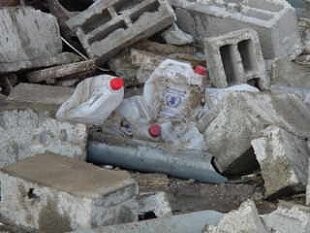2 December 2002
In response to the weekend demolition of a WFP warehouse by the Israeli Defence Forces, WFP is urging the Israeli government to observe humanitarian principles and compensate the agency for its losses.

Demolished warehouse (Photo: WFP, 2002)
Some 537 metric tons of food aid was being stored in a warehouse in the town of Jaballia in the northern part of the Gaza Strip which was targeted in a military incursion the night of November 30.
“The fact that WFP was not permitted to remove the food is worrisome,” said Jean-Luc Siblot, WFP country director.
“The food, which was housed on the ground floor of a three-storey building and clearly marked as WFP property, mainly comprised donations from the European Commission and Sweden and was to be distributed by the Ministry of Social Affairs to some 41,300 destitute people affected by the ongoing humanitarian crises in the Gaza Strip.”
The total value of the loss is estimated at US$271,000.
Well-marked
At approximately 22:50, the Israeli Defense Force surrounded the area and six tanks were parked in front of the building.
After requesting residents to evacuate their homes, IDF soldiers entered the building and conducted a search of the premises with dogs.
Despite the fact that the storage area was well marked as a WFP warehouse, with a large WFP flag and three WFP stickers on the doors, the soldiers proceeded to destroy the doors of the warehouse using tanks.
The owner of the building witnessed dynamite sticks being placed in various parts of the building and at approximately midnight, several blasts were heard, followed by a large explosion from a projectile dropped from a helicopter.
The building collapsed and everything left in it, including 413 tonnes of wheat flour, 107 tonnes of rice and 17 tonnes of vegetable oil, was destroyed.
“WFP should have been permitted to remove the food. This act has been carried out against basic humanitarian principles,” Siblot said.
“WFP is asking the Government of Israel to conduct a thorough investigation of the incident and take full responsibility for the losses incurred by the agency.”
Geography of Hunger on the West Bank/Gaza Strip
Hebron (457,781 inhabitants)
Bethlehem (153,954 inhabitants)
Jerusalem (367,000 inhabitants)
Ramallah (243,432 inhabitants)
Nablus (331,688 inhabitants)
Qalquilia (81,900 inhabitants)
Tulkaram (149,188 inhabitants)
Salfit (54,600 inhabitants)
Jenin (225,700 inhabitants)
Jericho (37,066 inhabitants)
Gaza Strip (1,196,000 inhabitants)